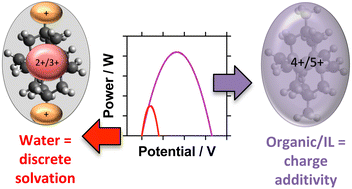High Seebeck coefficient thermogalvanic cells via the solvent-sensitive charge additivity of cobalt 1,8-diaminosarcophagine†
Abstract
Thermogalvanic devices can chemically convert low grade (<200 °C) waste thermal energy into electrical energy. A temperature gradient across the device drives an entropically favourable electrochemical redox reaction, resulting in continuous current production. The voltage correlates with the entropy change during the redox reaction, which favours high valence metal complexes with high charge densities. Here we investigate cobalt (II/III) sarcophagine ([Co(SAR)]2+/3+) for application in thermogalvanic cells, as a function of solvent; the two uncoordinated amine groups 1,8-diaminosarcophagine are typically protonated to form tetracationic/pentacationic [Co(SARH2)]4+/5+. In water, [Co(SARH2)]4+/5+ gave a thermogalvanic Seebeck coefficient (Se) of +0.43 mV K−1, which is entropically consistent with just the Co2+/3+ core valence, whereas DMSO and ionic liquid solvents gave Se values of +1.84 and +2.04 mV K−1, respectively, in line with the ‘Co4+/5+’ overall complex. This work proves how the ionic charge on pendant moieties can undergo charge-additivity with the metal core to significantly boost entropically-driven processes, but only in suitably low dielectric and bulky solvents.



 Please wait while we load your content...
Please wait while we load your content...